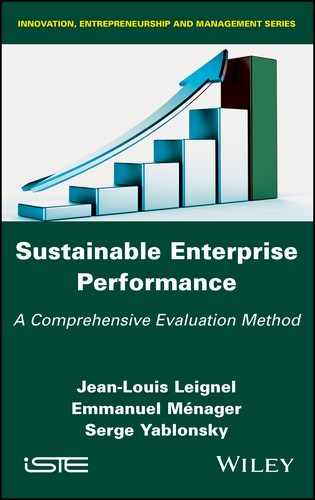Introduction
Knowing that more than half of the first 500 enterprises appearing in Fortune in 2000 have disappeared by 2018, which enterprises will still be present in 2020 or 2030? What differences do you see between well-known businesses such as Google, Walmart, General Electric, Holiday Inn or Toyota? Of course, they evolve in vastly different business areas. Furthermore, are there indicators that would allow us to compare their cyclical and future performance in terms of value creation?
Each one of them has management control and measurement procedures to measure their savings that, in their areas, provide information on their performance. But do these quantified and displayed results give a correct and comprehensive perception of their performance?
This book offers responses to questions by broadening traditional methods – generally accounting based – to more systematic performance criteria on the way businesses today move in their environments, movements that the digital revolution is currently revealing.
What do we see? Strategies more or less mindful of their environment. Agility more or less reactive to the expectations of the market and to the influence of their ecosystem. More or less attention to the adaptation of business models, to the quality and pertinence of the chosen operational processes.
Does that suffice? Each of the four cited businesses undoubtedly possesses a huge “corporate culture”, but it has been said that certain ones are no longer suitable to attract talent, to mobilize their internal resources in the best manner, and more simply, to entice a vaster clientele. Their internal cultures, by osmosis and whether they like it or not, from now on permeate the image that their “e-reputation” conveys.
We have analyzed work on “integral reporting”, which was developed to reinstate investors’ confidence. It emphasizes business’ financial performances, as well as social, environmental and governance (SEG) performances. It allows the promotion of sustainable development by proving to stakeholders that good practices in terms of corporate social responsibility (CSR) do not hinder financial growth, but on the contrary, they are a way to generate added value for the business.
The concept is promoted by the International Integrated Reporting Council (IIRC), an international association created in 2010 that gathers pilot enterprises, investors, reporting norm promoters and big audit firms.
Considering CSR in “integrated reporting” is undisputedly a step forward, but a business’ sustainable performance stems from a more global approach, integrating not only the process of governance and CSR criteria, but also the “supply creation” process and operational processes, without forgetting the importance of “enterprise culture”, “digital transformation”, ethics and compliance, the brand’s image and “Lean management”.
At the time of mass consumerism and savings called “shortages”, performance was measured in numbers that improved economies of scale and could be shown. This time is behind us. Today’s economy is strictly supply sided and must respond to the most diverse expectations on the market. The Japanese industry was the first to take on this course, since the beginning of the 1980s. A radical evolution occurred with “World Class Manufacturing”, which aims to produce varied available products with high quality at competitive prices. Lean manufacturing encodes its practices. In the same spirit, these practices now imbue governances and their administrations, services of all kinds, the development of digital systems, piloting start-ups and even the hospital sector.
Beyond the numbers, the control one has over these opportunities and their constraints – and good practices that increase a business’ profit – is determined by a global appreciation for the business’ performance.
If we cannot claim to measure everything with numbers like we do in management control, it is nevertheless possible to measure the maturity of a business with respect to a standard or another business. This work will therefore offer quantitative questionnaires for each domain of reference below: the evaluation of the maturity of the business, without neglecting quantitative approaches to management control such as ABC–ABM (activity-based costing/ management) and the balanced scorecard, made popular by Kaplan and Norton.
Even though it sometimes requires a global transformation, performance most often takes shape by means of an iteration of decisions, even microdecisions, in harmony with the business’ strategy, which must also be adapted with regard to the ecosystem in which the business finds itself. Microdecisions often take root around contacts with staff, suppliers, clients and even competitors. Over time the business will undergo a metamorphosis, maintaining contact with stakeholders, all while keeping performance in sight, which is the guarantee of its continuity.
In order to exhaustively cover the totality of domains where good practices must be applied in search of a business’ sustainable development, in the following, the authors offer a global framework, which consists of two distinct but complementary parts.
First, the main body of the text consists of:
- – The process of enterprise governance, comprising:
- - development of enterprise strategy;
- - CSR and sustainable development;
- - the translation of strategic objectives at the operational level;
- - monitoring the achievement of objectives and risk management;
- – The product offer creation process.
- – The operational processes of production of products and services.
The second part focuses on transversal topics that deserve particular attention, which are:
- - digital transformation;
- - enterprise culture;
- - ethics and compliance;
- - brand image and reputation;
- - Lean management.

With the goal of helping businesses evaluate their level of maturity in terms of sustainable performance, this framework for good practices was completed based on questionnaires related to each section in the chart.
Summaries of these questionnaires, developed for the purposes of this book, have been tested by interviews in firms of various sizes from various sectors in order to validate their operationality. An excerpt illustrating the approach can be found at the end of each chapter with a summary in the Appendix evaluating the maturity of French enterprises based on these questionnaires.
